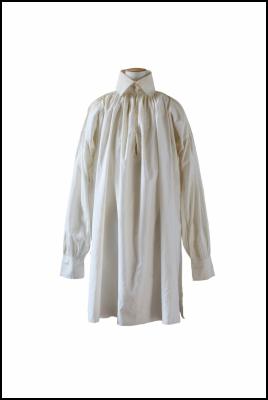Earliest surviving New Zealand garments at Te Waimate

John King’s shirt – the earliest example of a European-made garment in New Zealand for which we know the maker and wearer.
February
5
MEDIA RELEASE
Earliest surviving New Zealand garments at Te Waimate
Two of the country’s earliest surviving European-made garments are on display at Te Waimate Mission, the New Zealand Historic Places Trust property in Waimate North.
A christening gown and a man’s smock shirt are known to have been worn in New Zealand in the earliest years of European settlement, and take pride of place in New Zealand’s second oldest surviving historic building.
“The christening gown belonged to Thomas Holloway King, the first European child to have been born in New Zealand,” says the Manager of Te Waimate Mission, Mita Harris.
“Thomas was baptised by Rev Samuel Marsden in February 1815 at Rangihoua – just a couple of months after Marsden preached his famous Christmas sermon in December 1814. He lived with his mother and father, Hannah and John King, who were part of the first missionary settlement established at Rangihoua in the mouth of the Bay of Islands.”
Sadly, Thomas died only three years later from tuberculosis. His christening gown is a stark reminder of the harshness of life in early New Zealand, with the constant threat of child mortality hanging over most families.
The men’s smock shirt has a happier story behind it. The shirt belonged to John King; complete with hand-embroidered heart at the base of the neck opening of the shirt – an indicator that the shirt might have been a betrothal gift by Hannah prior to her marriage to John in 1812.
As well as the heart, the shirt is hand-sewn and includes the initials ‘JK’ cross-stitched in pink thread near the bottom right hand side of the shirt.
“The shirt is the earliest example of a European-made garment in New Zealand for which we know the maker and wearer.
“We know that Irish linen cloth was being imported into Sydney from 1803, so it’s possible that Hannah made both garments from this.”
Although neither garment is particularly grand, both speak volumes about the simplicity and hardship of life that was the reality for missionaries and their families – and the sewing skills required to make them.
“Both the gown and the shirt illustrate the importance of practical skills – like sewing – for missionaries; not only for their survival, but as skills that they could pass on to Maori as part of their evangelism initiatives,” says Mita.
“Some of the descendants of Hannah and John King still live in the Waimate North area, and we acknowledge their connection here, as well as the valuable family history that they bring to the Te Waimate Mission story.”
Te Waimate Mission is open daily over the summer holidays. For more information on NZ Historic Places Trust properties in Northland log on to www.historicplaces.org.nz
ENDS


 Hustle Management: Celebrating 50 Years Of Music, Now And Then, With Mark Williams
Hustle Management: Celebrating 50 Years Of Music, Now And Then, With Mark Williams Massey University: Birdnapped Cockatoo Wins Quote Of The Year
Massey University: Birdnapped Cockatoo Wins Quote Of The Year LAWA: “Know Before You Go” – Check Summer Swimming Water Quality Online
LAWA: “Know Before You Go” – Check Summer Swimming Water Quality Online Official Aotearoa Music Charts: 2024 End Of Year Charts Have Been Published
Official Aotearoa Music Charts: 2024 End Of Year Charts Have Been Published Nielsen Book NZ: Nielsen BookData Announces 'In Too Deep' Is The Official New Zealand Number 1 Christmas Bestseller
Nielsen Book NZ: Nielsen BookData Announces 'In Too Deep' Is The Official New Zealand Number 1 Christmas Bestseller PHARMAC: Pharmac Consulting On Six Medicines For New Zealanders
PHARMAC: Pharmac Consulting On Six Medicines For New Zealanders